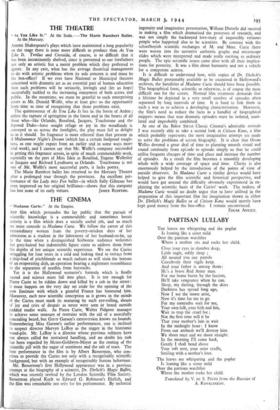Madame Curie." At the Empire. THE CINEMA
ANY film which persuades the lay public that the pursuit of scientific knowledge is a commendable and sometimes heroic activity is a film which does a socially useful job, and so much we must concede to Madame Curie. We follow the career of this extraordinary woman from the poverty-stricken days of her admission as a student in the laboratory of her husband-to-be, up to the time when a distinguished Sorbonne audience welcomes her grey-haired but indomitable figure come to address them from the depths of her unique scientific experience. We see the Curies struggling for four years in a cold and leaking shed to extract from a ship-load of pitchblende as much radium as will stain the bottom of an evaporating dish, an operation bearing a nightmare resemblance to the separation of needles from haystacks.
Yet it is the Hollywood scenarist's formula which is finally sacred and science must fall into place. It is not enough for Pierre Curie to be ridden down and killed by a cab in the street: it must happen on the very day set aside for the opening of the new Institute with which a grateful France has honoured him. Moreover, each new scientific conception as it grows in the minds of the Curies must mark its maturing by such eye-rolling, shouts of joy and cries of despair as never were seen or heard outside padded studio walls. As Pierre Curie, Walter Pidgeon manages to achieve some measure of restraint with the aid of a mercifully concealing beard, but Greer Garson's extroversion knows no. bounds. Remembering Miss Garson's earlier performances, one is inclined to suspect director Mervyn LeRoy as the nigger in the histrionic wood-pile. Mr. LeRoy is a director whose previous subjects have not always called for restrained handling, and no doubt his task has been regarded by Metro-Goldwyn-Mayer as the coating of the scientific pill with the sugar of sentiment and the salt of tears. The best performance in the film is by Albert Basserman, who con- trives to provide the Curies not only with a recognisably scientific background, but with an example of recognisably human behaviour.
Mr. Basserman's first Hollywood appearance was in a previous attempt at the biography of a scientist, Dr. Ehrlich's Magic Ballet, which was recently revived by the London Scientific Film Society. Basserman played Koch to Edward G. Robinson's Ehrlich, and the film was remarkable not only for his performance. By technical ingenuity and imaginative presentation, William Dieterle did succeed in making a film which dramatised the processes of research, and was not simply the hackneyed love-story of impossibly virtuous people who happened also to be scientists. By contrast with the schoolboyish scientific exchanges of M. and Mme. Curie there were woven into the narrative authentic graphs and microscope slides which were interpreted and made really exciting to ordinary people. The epic scientific issues came alive with all their implica- tions for posterity. It was a film about humanity and not a vehicle for a competent actress.
It is difficult to understand how, with copies of Dr. Ehrlich's Magic Bullet presumably available to be examined in Hollywood's archives, the banalities of Madame Curie should have been possible. The biographical form, scientific or otherwise, is of course the most difficult one for the screen. Normal film treatment demands that a lifetime be depicted in a very small number of episodes often separated by long intervals of time. It is hard to link them in such a way as to achieve a developing characterisation. Moreover, the film's need to reduce the facts to a handful of biographical snippets means that true dramatic episodes must be isolated, muti- lated and improbably combined.
At one of the Baker Street Classic Cinema's admirable revivals I was recently able to take a second look at Citizen Kane, a film which probably represents the most imaginative attempt yet made to solve the problems of screen biography. It is clear that Orson Welles devoted a great deal of time to planning smooth visual and sound continuity from episode to episode simply so that he could utilise frequent changes of time and place and increase the number of episodes. As a result the film becomes a smoothly developing whole with a wide coverage of space and time. Clarity is also enormously helped by the introduction of the points of view of outside observers. In Madame Curie a similar device would have helped to give the film scientific and historical perspective, and would have got around the difficulty obviously experienced in ex- plaining the scientific basis of the Curies' work. The makers of Madame Curie would no doubt argue that to have utilised in the preparation of this important film the imagination shown in either Dr. Ehrlich's Magic Bullet or of Citizen Kane would merely have kept good money from the box-office. 1 remain unconvinced.
EDGAR ANSTEY.


























 Previous page
Previous page